Could you please elaborate a bit on how you arrived at the answer?
Well, the main problem consists in getting a fair way to sample the non-uniform distribution of coordinate X.
From elementary geometry, the area of the part of the upper triangle with x < x0 is: (1/2) * (x0 + 1)2. As the total area of this upper triangle is equal to 2, it follows that the cumulative probability P of (X < x0) within the upper triangle is: P = (1/4) * (x0 + 1)2.
So, inverting the last formula, we have: x0 = 2*sqrt(P) - 1
Now, from the Inverse Transform Sampling theorem, we know that we can generate a fair sampling of X by reinterpreting P as a random variable U0 uniformly distributed between 0 and 1.
In Python, this gives us:
u0 = random.uniform(0.0, 1.0)
x = (2*math.sqrt(u0)) - 1.0
or equivalently:
u0 = random.random()
x = (2 * math.sqrt(u0)) - 1.0
Note that this is essentially the same maths as in the excellent answer by @SamMason. That thing comes from a general statistical principle. It can just as well be used to prove that a fair sampling of the latitude on a 3D sphere is given by arcsin(2*u - 1).
So now we have x, but we still need y. The underlying 2D density is an uniform one, so for a given x, all possible values of y are equidistributed.
The interval of possible values for y is [-x, 1]. So if U1 is yet another independent random variable uniformly distributed between 0 and 1, y can be drawn from the equation:
y = (1+x) * u1 - x
which in Python is rendered by:
u1 = random.random()
y = (1+x)*u1 - x
Overall, the Python code can be written like this:
import math
import random
import matplotlib.pyplot as plt
def mySampler():
u0 = random.random()
u1 = random.random()
x = 2*math.sqrt(u0) - 1.0
y = (1+x)*u1 - x
return (x,y)
#--- Main program:
points = (mySampler() for _ in range(10000)) # an iterator object
xx, yy = zip(*points)
plt.scatter(xx, yy, s=0.2)
plt.show()
Graphically, the result looks good enough:

Side note: a cheaper, ad hoc solution:
There is always the possibility of sampling uniformly in the whole square, and rejecting the points whose x+y sum happens to be negative. But this is a bit wasteful. We can have a more elegant solution by noting that the “bad” region has the same shape and area as the “good” region.
So if we get a “bad” point, instead of just rejecting it, we can replace it by its symmetic point with respect to the x+y=0 dividing line. This can be done using the following Python code:
def mySampler2():
x0 = random.uniform(-1.0, 1.0)
y0 = random.uniform(-1.0, 1.0)
s = x0+y0
if (s >= 0):
return (x0, y0) # good point
else:
return (x0-s, y0-s) # symmetric of bad point
This works fine too. And this is probably the cheapest possible solution regarding CPU time, as we reject nothing, and we don't need to compute a square root.



